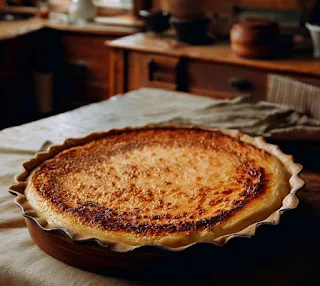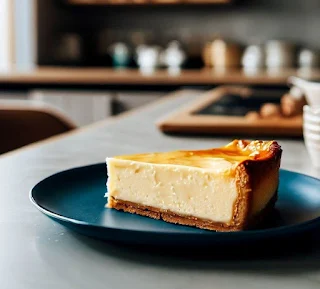By embracing and delving into recipes like Melktart, we not only broaden our gastronomic repertoire but also develop a deeper understanding and appreciation for the vibrant cultural heritage of South Africa. It's an opportunity to embark on a flavorful journey that celebrates the tastes and traditions that make South African cuisine unique and remarkable.
South African Melktart recipe is similar to enjoying American Custard Pie settling reservations about trying South African dessert recipes.
Melktart and Custard Pie first share a common base ingredient: milk. The name Melktart actually translates to milk tart in English, highlighting its primary ingredient. Similarly, Custard Pie is renowned for its silky-smooth filling with rich, creamy milk. So, if you're a fan of a pie's velvety, custard-like texture, you're in for a treat with both these desserts.
Moving on to the flavor profiles, Melktart and Custard Pie offer a delightful blend of sweetness and subtle spices. In the case of Melktart, it features a delicate balance of vanilla and cinnamon, infusing the creamy custard with warmth and aromatic goodness. On the other hand, Custard Pie often incorporates flavors like nutmeg or even a touch of lemon zest, adding a unique twist to the custard base. These flavor combinations make both desserts irresistibly delicious and enjoyable.
Another aspect that connects these two treats is their simplicity and the use of everyday pantry staples. South African Melktart and Southern American Custard Pie are cherished homemade recipes passed down through generations, emphasizing their popularity and enduring appeal. They are made using readily available ingredients like eggs, sugar, flour, and milk. This accessibility ensures that you can easily recreate these recipes in your own kitchen, regardless of where you are in the world.
Furthermore, it's important to note that trying different cuisines broadens our culinary horizons and allows us to appreciate diverse flavors and cultures. South African cuisine, including Melktart, offers a unique blend of African, European, and Asian influences, resulting in a delightful fusion of flavors. By embracing and exploring recipes like Melktart, you not only expand your gastronomic repertoire but also gain a deeper understanding and appreciation for the rich cultural heritage of South Africa.
Ultimately, the beauty of food lies in its ability to unite people, transcending borders and bridging cultural divides. So, even if you have reservations about trying African food, remember that Melktart and Custard Pie share common elements that make them equally delightful and satisfying desserts. By exploring these recipes, you embark on a culinary adventure that allows you to appreciate the similarities and celebrate the differences between diverse food traditions. Give it a try, and you may discover a newfound love for the flavors of South Africa while enjoying the comfort of a classic American pie.
History of Custard Pie and a simple recipe.
Custard Pie has its roots in European culinary traditions. The concept of custards and custard-filled pastries can be traced back to medieval Europe, where custards were a typical sweet dish enjoyed by the nobility and the upper classes. As European settlers migrated to America, they brought their culinary traditions, including the love for custards.
Over time, as American cuisine developed and evolved, Custard Pie became a popular dessert, especially in the southern states. It became associated with Southern American cuisine, often served during holidays and special occasions. Its simplicity, comforting taste, and use of essential ingredients made it a staple in many households.
Custard Pie has remained a cherished dessert throughout American history, with many regional variations and family recipes adding their unique touches. It has also found its way into other cuisines and cultural traditions, adapting and incorporating local flavors and ingredients.
Today, Custard Pie continues to be enjoyed across the United States and beyond. Its timeless appeal lies in its smooth, custard-like texture and delicate sweetness. Whether served warm or chilled, it remains a delightful treat that pays homage to the culinary heritage of generations past.
Recipe to make a Custard Pie.
Ingredients:
1 9-inch pie crust (store-bought or homemade)
4 large eggs
1/2 cup granulated sugar
1/4 teaspoon salt
2 1/2 cups whole milk
1 teaspoon vanilla extract
Ground nutmeg (for sprinkling on top)
Directions:
Preheat your oven to 350°F (175°C). Roll out the pie crust and line a 9-inch pie dish. Trim any excess dough and crimp the edges.
Whisk the eggs, sugar, and salt in a mixing bowl until well combined. Heat the milk in a saucepan over medium heat until it is scalding hot (small bubbles form around the edges but not boiling).
Slowly pour the hot milk into the egg mixture, whisking continuously. Add the vanilla extract and whisk until the mixture is smooth.
Pour the custard filling into the prepared pie crust. Sprinkle a pinch of ground nutmeg on top of the custard. Carefully place the pie in the preheated oven and bake for about 45-50 minutes until the center is set and the top is lightly golden.
Remove the pie from the oven and let it cool completely before serving.
South African Melktart Recipe.
Ingredients:
1 9-inch pie crust store-bought or homemade
4 cups whole milk
1/2 cup all-purpose flour
1/2 cup granulated sugar
3 large eggs
1 teaspoon vanilla extract
1 teaspoon ground cinnamon
Directions:
Heat the milk over medium heat in a saucepan until it reaches a scalding point (small bubbles form around the edges, but it's not boiling). Preheat your oven to 350°F (175°C).
Whisk together the flour, sugar, eggs, vanilla extract, and ground cinnamon in a separate bowl until well combined.
Slowly pour the hot milk into the egg mixture while whisking continuously. This helps to temper the eggs and prevent them from scrambling.
Pour the mixture back into the saucepan and cook over medium-low heat, stirring constantly, until the filling thickens to a custard-like consistency. This usually takes about 5-7 minutes. Remove from heat and set aside.
Take the chilled dough out of the refrigerator and roll it out on a floured surface to fit the size of your pie dish. Carefully transfer the dough to the dish and press it into the bottom and sides.
Pour the prepared custard filling into the crust, spreading it evenly.
Bake the Melktart in the preheated oven for about 25-30 minutes or until the crust turns golden and the filling is set.
Remove the Melktart from the oven and let it cool to room temperature before refrigerating it for at least 2 hours or until chilled.
Once chilled, you can sprinkle some ground cinnamon on top for garnish.

Connecting South African Melktart and American Custard Pie Desserts.
Both the South African Melktart and American Custard Pie hold a special place in the hearts of families, as these cherished homemade recipes have been lovingly passed down through generations. Their enduring appeal lies in their simplicity and the use of everyday pantry staples.
With common ingredients like eggs, sugar, flour, and milk, these recipes can be easily recreated in any kitchen, no matter where you are in the world. The accessibility of these ingredients ensures that you can enjoy the comforting flavors of Melktart and Custard Pie, connecting you to the culinary traditions and heritage of South Africa and the United States.
Custard Pie and Melktart are chilled and delightful desserts that showcase a smooth and creamy custard filling encased in a flaky pastry crust. Slice it into portions and savor the creamy, spice-infused custard in every bite.






